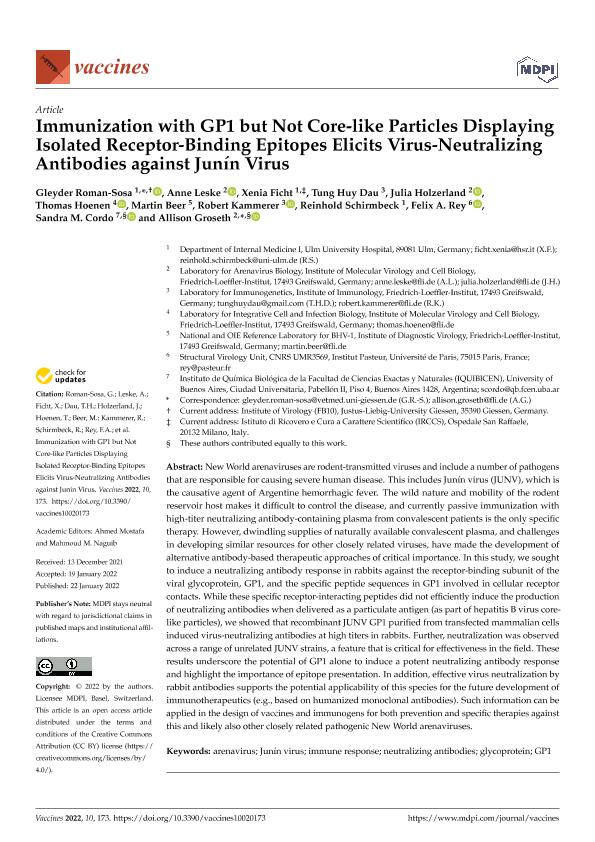Mostrar el registro sencillo del ítem
dc.contributor.author
Roman Sosa, Gleyder
dc.contributor.author
Leske, Anne
dc.contributor.author
Ficht, Xenia
dc.contributor.author
Dau, Tung Huy
dc.contributor.author
Holzerland, Julia
dc.contributor.author
Hoenen, Thomas
dc.contributor.author
Beer, Martin
dc.contributor.author
Kammerer, Robert
dc.contributor.author
Schirmbeck, Reinhold
dc.contributor.author
Rey, Felix A.
dc.contributor.author
Cordo, Sandra Myriam

dc.contributor.author
Groseth, Allison
dc.date.available
2023-09-29T17:16:04Z
dc.date.issued
2022-02
dc.identifier.citation
Roman Sosa, Gleyder; Leske, Anne; Ficht, Xenia; Dau, Tung Huy; Holzerland, Julia; et al.; Immunization with GP1 but Not Core-like Particles Displaying Isolated Receptor-Binding Epitopes Elicits Virus-Neutralizing Antibodies against Junín Virus; MDPI; Vaccines; 10; 2; 2-2022; 1-19
dc.identifier.issn
2076-393X
dc.identifier.uri
http://hdl.handle.net/11336/213629
dc.description.abstract
New World arenaviruses are rodent-transmitted viruses and include a number of pathogens that are responsible for causing severe human disease. This includes Junín virus (JUNV), which is the causative agent of Argentine hemorrhagic fever. The wild nature and mobility of the rodent reservoir host makes it difficult to control the disease, and currently passive immunization with high-titer neutralizing antibody-containing plasma from convalescent patients is the only specific therapy. However, dwindling supplies of naturally available convalescent plasma, and challenges in developing similar resources for other closely related viruses, have made the development of alternative antibody-based therapeutic approaches of critical importance. In this study, we sought to induce a neutralizing antibody response in rabbits against the receptor-binding subunit of the viral glycoprotein, GP1, and the specific peptide sequences in GP1 involved in cellular receptor contacts. While these specific receptor-interacting peptides did not efficiently induce the production of neutralizing antibodies when delivered as a particulate antigen (as part of hepatitis B virus core-like particles), we showed that recombinant JUNV GP1 purified from transfected mammalian cells induced virus-neutralizing antibodies at high titers in rabbits. Further, neutralization was observed across a range of unrelated JUNV strains, a feature that is critical for effectiveness in the field. These results underscore the potential of GP1 alone to induce a potent neutralizing antibody response and highlight the importance of epitope presentation. In addition, effective virus neutralization by rabbit antibodies supports the potential applicability of this species for the future development of immunotherapeutics (e.g., based on humanized monoclonal antibodies). Such information can be applied in the design of vaccines and immunogens for both prevention and specific therapies against this and likely also other closely related pathogenic New World arenaviruses.
dc.format
application/pdf
dc.language.iso
eng
dc.publisher
MDPI
dc.rights
info:eu-repo/semantics/openAccess
dc.rights.uri
https://creativecommons.org/licenses/by/2.5/ar/
dc.subject
ARENAVIRUS
dc.subject
GLYCOPROTEIN
dc.subject
GP1
dc.subject
IMMUNE RESPONSE
dc.subject
JUNÍN VIRUS
dc.subject
NEUTRALIZING ANTIBODIES
dc.subject.classification
Virología

dc.subject.classification
Ciencias Biológicas

dc.subject.classification
CIENCIAS NATURALES Y EXACTAS

dc.title
Immunization with GP1 but Not Core-like Particles Displaying Isolated Receptor-Binding Epitopes Elicits Virus-Neutralizing Antibodies against Junín Virus
dc.type
info:eu-repo/semantics/article
dc.type
info:ar-repo/semantics/artículo
dc.type
info:eu-repo/semantics/publishedVersion
dc.date.updated
2023-07-07T22:49:19Z
dc.journal.volume
10
dc.journal.number
2
dc.journal.pagination
1-19
dc.journal.pais
Países Bajos

dc.journal.ciudad
Basel
dc.description.fil
Fil: Roman Sosa, Gleyder. Ulm University Hospital; Alemania
dc.description.fil
Fil: Leske, Anne. Friedrich-Loeffler-Institut; Alemania
dc.description.fil
Fil: Ficht, Xenia. Ulm University Hospital; Alemania
dc.description.fil
Fil: Dau, Tung Huy. Friedrich-Loeffler-Institut; Alemania
dc.description.fil
Fil: Holzerland, Julia. Friedrich-Loeffler-Institut; Alemania
dc.description.fil
Fil: Hoenen, Thomas. Friedrich-Loeffler-Institut; Alemania
dc.description.fil
Fil: Beer, Martin. Friedrich-Loeffler-Institut; Alemania
dc.description.fil
Fil: Kammerer, Robert. Friedrich-Loeffler-Institut; Alemania
dc.description.fil
Fil: Schirmbeck, Reinhold. Friedrich-Loeffler-Institut; Alemania
dc.description.fil
Fil: Rey, Felix A.. Friedrich-Loeffler-Institut; Alemania
dc.description.fil
Fil: Cordo, Sandra Myriam. Consejo Nacional de Investigaciones Científicas y Técnicas. Oficina de Coordinación Administrativa Ciudad Universitaria. Instituto de Química Biológica de la Facultad de Ciencias Exactas y Naturales. Universidad de Buenos Aires. Facultad de Ciencias Exactas y Naturales. Instituto de Química Biológica de la Facultad de Ciencias Exactas y Naturales; Argentina
dc.description.fil
Fil: Groseth, Allison. Friedrich-Loeffler-Institut; Alemania
dc.journal.title
Vaccines
dc.relation.alternativeid
info:eu-repo/semantics/altIdentifier/doi/http://dx.doi.org/10.3390/vaccines10020173
Archivos asociados
